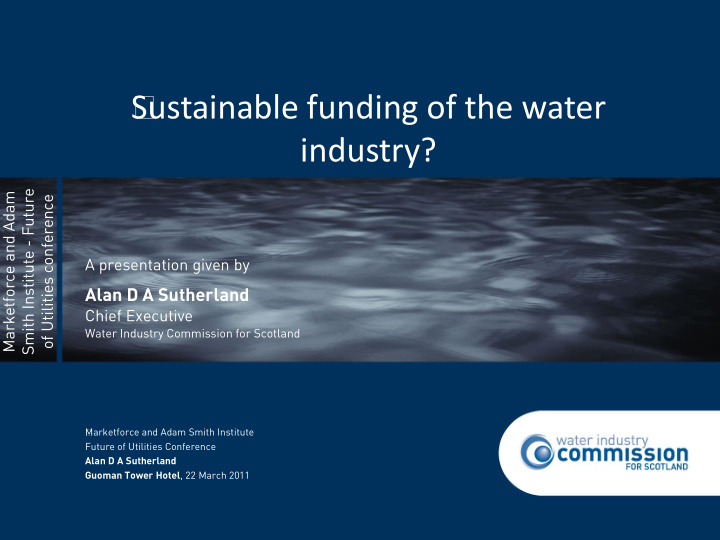



Sustainable funding of the water industry? A presentation given by Alan D A Sutherland Chief Executive Water Industry Commission for Scotland Marketforce and Adam Smith Institute Future of Utilities Conference Alan D A Sutherland Guoman Tower Hotel , 22 March 2011
Our experience is that the separation has created value and pays back in five years..... PV of all PV of all PV of cash costs & costs & spent & savings if no savings with savings NPV further dynamic already efficiency efficiencies realised • The Commission spent £5.7m (funded by grant). Set up • The Scottish Water Group spent £13.6m. This was -£22m -£22m -£22m capitalised*. costs • CMA set up costs were £3.2m. • Regulator’s levy of £1.2m. Ongoing • CMA costs of £2.5m. -£9m -£119m -£119m costs • Extra cost of capital of £0.7m . • Assuming Business Stream would have improved at the same Current rate as Scottish Water since 2006-07, it has further reduced +£18m +£279m +£279m savings costs by £8.1m per year. achieved • No savings achieved by Scottish Water have been included. Savings +£85m from • Incremental retail efficiencies (1% per year) dynamic • Incremental wholesale efficiencies (0.05% per year) +£110m efficiency NPV -£13m +£138m +£333m 2
Separating retail and wholesale in England and Present Present Value of all Value of all Wales is likely to deliver even more benefits..... costs and costs and savings savings with without dynamic dynamic efficiency • Assume conservatively that companies south of the border incur same efficiency costs per non-household customer: • No allowance for codes already working; and Set up • No allowance for experience already earned. -£182m costs -£182m • Assume CMA to be fit for purpose for pan-GB market: £10 million new expenditure • Assume Ofwat costs to implement framework: £8 million new expenditure • Assume CMA operating costs increase to £10m per year – a £7.5m Ongoing increment. -£529m -£529m • Assume extra costs for Ofwat of £2m a year. costs • Assume extra costs of capital allowance of £6m a year. • Assume no mergers. Ongoing +£1479m • Assume on average companies achieve only 2/3 rds of the savings +£1479m cost achieved by Business Stream. reductions +£734m • Incremental retail efficiencies (1% per year) Dynamic • Incremental wholesale efficiencies (0.05% per year) efficiency +£988m NPV +£768m +£2.5bn 3
Actually separation does not need to lead to losses in economies of scope and it boosts efficiency- Wessex and Scottish Water stand out…. • Wessex and Bristol Water established Total operating costs including depreciation/ a customer services joint venture non-household revenue 9% company some ten years ago. 8% 7% • Glas Cymru tendered its retail services 6% separately from operations. 5% 4% • United Utilities established Vertex to 3% handle its customer services, and 2% have subsequently moved away from 1% this model. 0% • Many other water and sewerage companies have chosen to out-source elements of retail activities, such as call centres, meter reading and billing. source: OFWAT June Return 2010, table 21b and table 23
Our statutory duty was to do no ‘detriment’ to the core (wholesale) business of Scottish Water. • We did not sub-divide the RCV; • We allowed for the same WACC as before the separation; • We require the licensed providers to pre-pay the wholesale charges due to Scottish Water; • We allowed for an additional return to be earned by the retail business; • We allowed for the additional costs of the new market framework, but offset these with an additional efficiency challenge; • No new investment capital was required; • Set-up costs were capitalised, allowing a return to be earned. • Business Stream stays part of the Scottish Water Group for as long as its owners decide this to be appropriate. 5
Find out more at: www.watercommission.co.uk www.scotlandontap.gov.uk
Recommend
More recommend